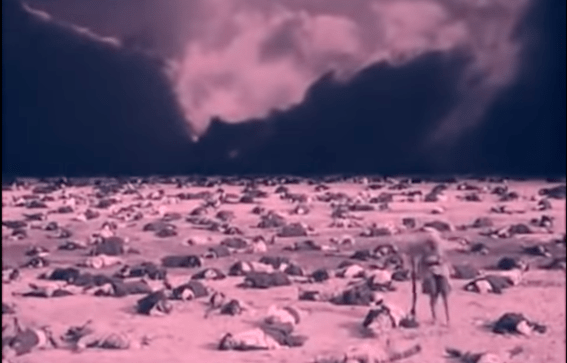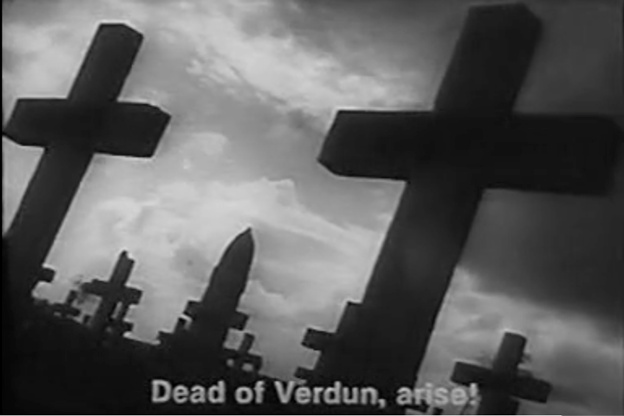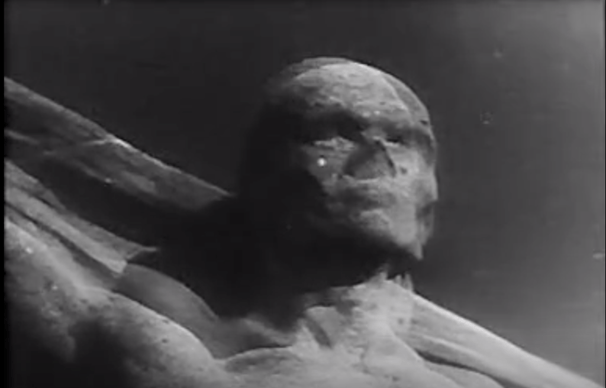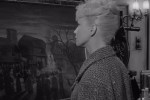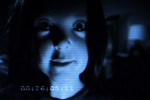Elizabeth Tussey
Abel Gance’s 1919 silent film, J’accuse, “I Accuse,” captured the terrestrial horrors of World War I in real time and features authentic images of battlefields and soldiers. In 1938, during the early rumblings of World War II, Gance rebooted his own film. While the narrative of the first half of these films features melodramatic storylines grounded in reality (a love triangle in J’accuse (1919), and a staunch anti-war plot in the 1938 version), both feature the same horrific ending. In the final act of both films, deceased soldiers rise from their graves and march back to confront civilian villagers to see if their sacrifices have been in vain.
To the modern viewer, scenes of the undead soldiers shambling en masse towards the living represent a familiar trope. J’accuse (1919) features the first appearance of zombies on film1. However, the most haunting legacy of the 1919 film is that the majority of the soldier-actors featured in the final act died in subsequent battles within weeks of appearing on film. J’accuse (1919) also features documentary footage of the Battle of St. Mihiel, taken by Gance while he was serving as an army cinematographer. In the second version of J’accuse, Gabel hired veterans of World War I to play the undead soldiers marching amid footage of The Douaumont Ossuary, a memorial to soldiers killed during the Battle of Verdun. Many of these veterans had facial differences from wounds received during their service. Their appearance is both an authentic testament to the brutality of World War I and a warning of impending bloodshed. Like modern found footage films, Gance grounds the horrors of J’accuse in the space where the plausible merges with the supernatural, lending an air of authenticity to the implausible. Unlike modern found footage films that rely on fictional signifiers of veracity, Gance’s use of ‘found’ footage is, in fact, authentic. I propose that both uniquely authentic versions of J’accuse should be considered the first found footage horror films.
Abel Gance, who is not as well-remembered as his contemporaries, was an innovative forerunner in filmmaking for several reasons. In addition to his unorthodox usage of documentary footage and real subjects, his work features techniques that were cutting-edge by early 20th century standards. Throughout his early career, these experimental approaches to filmmaking were met with anger and pushback from various French studios. For example, even Gance’s use of close-up shots, a practice common in early American filmmaking, was considered too avant garde for mainstream French audiences at the time. When World War I started, Gance served in the French army as a battlefield cinematographer. Gance’s documentary footage would eventually make its way into J’accuse (1919). He was discharged from service due to chronic health issues before the end of the war. Despite initial difficulties, he eventually found funding for J’accuse and began filming during the final months of World War I (Brownlow, The Parade’s Gone By 596-620). In an interview with film historian Kevin Brownlow, Abel Gance recounts the poignant experience of working with the soldiers who comprised his horde of revenants:
We made the film under very moving circumstances, because the men you see in the film who play the Dead Returned were men from the front, from Verdun. They came on eight days’ leave. I had those 2,000 soldiers who knew they’d never survive that hell. They had seen it all, and now they played the dead knowing they would probably die themselves. This drama, the source of the psychological impact, stems from the acting of those dead men on leave. In a few weeks or months, eighty per cent of them would disappear. I knew it and so did they. This was the atmosphere in which the film was shot, and it gave me the courage to make the film, which may be melodramatic, but intrinsically it is based on a very moving situation. (Brownlow, Napoleon 28)
The plot of the first film, as Gance himself states, is overwrought and coded with misogynist tropes. The main characters, poet Jean Diaz (Romuald Joubé) and François Laurin (Séverin-Mars), love the same woman and face intense interpersonal disputes as they leave for war. They ultimately reconcile during battle and, after François Laurin dies, the traumatized Jean Diaz endures horrific hallucinations. He witnesses his comrades emerge from their graves and march to a nearby village to judge their living loved ones. The line between hallucination and reality blurs as the villagers themselves witness the return of the dead. After the ghostly horde return to their graves, Jean Diaz pens one final, accusatory poem. He indicts the sun itself for complicity in the horrors of war and, ostensibly, succumbs to his fatal madness.
J’accuse (1919) arrived in theatres after the armistice but remained emotionally effective to French and British audiences. Gance’s agent telegraphed him after the film premiered in London to report several instances of women fainting in the theatres at the very thought of their deceased loved ones returning from the grave (Brownlow, Napoleon 29). Even the supernatural elements of J’accuse were plausible for some audience members at the time. Van Kelly cites various scholars and notes the superstitious attitudes among both soldiers and civilians during World War I. Stories of ghostly soldiers appearing mid-battle to support their living comrades were so prevalent the French army commissioned a study to investigate these supernatural reports. Kelly observes that “Gance’s silent film reflects an era where the proximity of death encouraged belief in the uncanny and the supernatural” (9). Although the authentic footage of battlefields and the use of real soldiers as actors is filmed in the context of Jean Diaz’s hallucination of an impossible resurrection, such events were believable to many film goers during the post-war years.
When Gance rebooted a sound version of J’accuse almost twenty years later, he retained the main character of the first film, Jean Diaz (Victor Francen). Instead of revisiting the love triangle of the previous film, Gance retooled the first half of the plot. Jean Diaz, horrified by his experiences as a soldier during World War I, dedicates his life to creating anti-war technology. When his efforts are ignored, he appeals to the dead soldiers of Verdun to intercede as his nation and society steadily march towards another deadly global conflict. In the final act, Gance recreates the ghastly march of the resurrected dead as they respond to Diaz’s pleas. Van Kelly describes how Gance made sure to incorporate an equally poignant and harrowing authenticity in the final act of J’accuse (1938):
In the sound remake of 1938, the landscape for the return of the dead is furnished differently, by the imposing anthropomorphic tower of the ossuary at Douaumont whose ominous flashing scowl keeps watch over the dead of the battle of Verdun and complements the superimposed images of soldiers who had survived the war but with piteous facial deformities. An officer from the French army, Colonel Picot, had organized these war invalids into the [National Federation of the Trepanned and Facially Wounded Soldiers], known for short as the Gueules Cassées, or Broken Faces. The group militated against civilian forgetfulness of 1914-1918. (Kelly 10)
In J’accuse (1919), the viewer is distanced from the horde of undead soldiers. The two-thousand soldiers fill the frame and, while some bandages and wounds are visible, the group blends together into an indistinguishable mass for most of the scene. In the 1938 version, Gance lingers over the faces of individual veterans, allowing the viewer to take in the full extent of their wounds (Kelly 10). Not only is the authentic nature of battle wounds preserved in this scene, the mission of the soldier-actors from Gueules Cassées — to have their bodily sacrifices witnessed and remembered, is documented and recognized every time this film is viewed.
For a found footage film to have emotional impact on an audience, the film must overcome obstacles that conflict with the suspension of disbelief concerning the veracity of the ‘found’ footage. Because J’accuse (1919) has no predecessors in this genre, Gance’s usage of documentary footage has no cinematic tropes to follow or, conversely, mold to break. However, early found footage films are the spiritual cinematic successors to the literary trope of found manuscripts. Tomasz Sawczuk examines the bridge between narrative frames used in found manuscript novels and found footage films in his article, “Taking Horror as You Find It: From Found Manuscripts to Found Footage Aesthetics.” In his analysis, Sawczuk discusses how Gothic writers such as Horace Walpole, Mary Shelley, and Bram Stoker “simultaneously counterfeit authenticity and distance their authorship” by employing found manuscripts in their work (225). When applying this framework to Gance’s J’accuse, we can see how his film is able to break from the necessity of distance due to the inherently authentic nature of the footage used. One such example is the specificity of time and place in both versions of J’accuse. This strategy counters the vagueness of location and time employed by some found manuscript authors to make claims of veracity plausible to the reader. Sawczuk cites an example of this strategy in Walpole’s The Castle of Otranto: “The remoteness of the purported time and place of its origin…allows Walpole to feign historicity of the artifact and, on the other, is conducive to legitimizing the uncanniness which is about to follow” (225).
Much like Walpole’s found manuscript novel, the found footage elements of Gance’s film precede and ground the viewer as supernatural events unfold. The procession of undead soldiers in J’accuse (1919) sidesteps any need for distance for the sake of authenticity due to the veracity of the footage. J’accuse (1938) also has no need for distance as both the wounded soldiers and the anthropomorphized monuments are real. As previously mentioned, the wounded soldier-actors comprising the horde of resurrected soldiers also provide a devastating context to this scene. Another chilling relic of authenticity present in this scene concerns the gruesome contents of The Douaumont Ossuary. Following a similar visual pattern established by the combination of real soldiers amid the backdrop of a real battlefield in his first iteration of J’accuse, Gance captures the healed wounds of his solider-actors amid landscapes memorializing the dead of Verdun. The soldiers who appear in the death march of J’accuse (1919) were recent survivors of this battle and served alongside the men whose earthly remains rest just out of frame in Gance’s anthropomorphized yet authentic memorial backdrop to the final act of J’accuse (1938).
Another modern found footage convention examined in Sawczuk’s article is the use of textual items as relics of authenticity. Instead of relying on textual items or other artifacts to claim authenticity, Gance relies on the injured bodies of his soldier-actors and the shattered landscape of the battlefield. I propose that these unorthodox signifiers fall into what Sawczuk considers the “realm of intersemiotic translation, also known as transmutation” (229). The viewer ‘reads’ the landscape and the broken bodies of the men. Without the use of these authentic signifiers—both in the form of living veterans as well as existing memorial landscapes—Gance’s story would not function as effectively as it does and would most certainly require the use of fictional signifiers of veracity common in modern found footage films.
J’accuse (1919) is unique for several reasons—Gance provides us with the first vision of zombies, the first post-war horror film, and the first found footage film. Furthermore, both versions of J’accuse bear lasting witness to the ruinous work of warfare. Over a century has passed since Gance captured those doomed soldiers on film. In addition to creating the first found footage film, Gance has provided future audiences with something much deeper and equally as authentic as his footage—the preservation of sacrifices and anxieties as the war machine churned on. A century later, film audiences still find terror in the perceived authenticity of found footage, and Gance’s prophetic witness to and warning of unending war remains as relevant, horrifying, and immediate as it was in 1919.
Notes
- W. Scott Poole positions J’accuse as the first post-war horror film as well as the first zombie film in his book, Wasteland: The Great War and the Origins of Modern Horror.
Works Cited
Brownlow, Kevin. Napoleon, Abel Gance’s Classic Film. 1st ed. Knopf, 1983.
—. The Parade’s Gone By… 1st ed. Ballantine Books, 1970.
J’accuse. Directed by Abel Gance, Olive Films, 2016.
—. Directed by Abel Gance, Flicker Alley, 2018.
Kelly, Van. “The Ambiguity of Individual Gestures: Revisions of World War I in Abel Gance’s ‘J’accuse,’ Alain’s ‘Mars Ou La Guerre Jugée,’ and Bertrand Tavernier’s ‘La Vie et Rien d’autre.’” South Central Review, vol. 17, no. 3, 2000, pp. 7–34.
Poole, W. Scott. Wasteland: The Great War and the Origins of Modern Horror. Counterpoint, 2018.
Sawczuk, Tomasz. “Taking Horror as You Find It: From Found Manuscripts to Found Footage Aesthetics.” Text Matters: A Journal of Literature, Theory and Culture, no. 10, 10, Nov. 2020, pp. 223–35.

